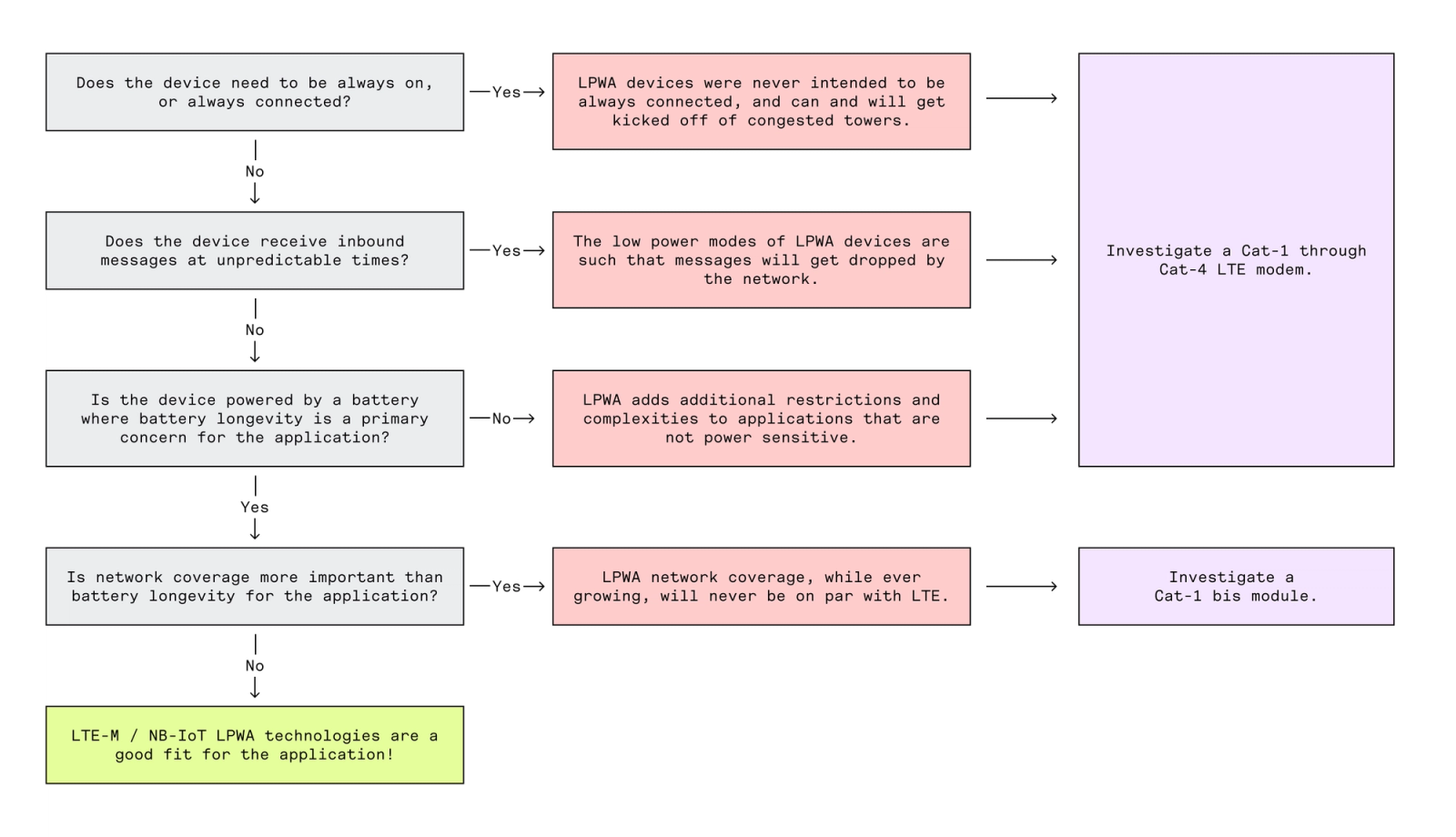When to Use LTE CAT M Technology for Cellular IoT Deployments

LTE CAT M, also known as LTE-M, is a cellular technology specifically designed for IoT applications. It offers several advantages, but it is not a one-size-fits-all solution.
As the Internet of Things (IoT) continues to expand, choosing the right cellular technology for your IoT deployment becomes increasingly important. LTE CAT M, also known as LTE-M, is a cellular technology specifically designed for IoT applications. It offers several advantages, but it is not a one-size-fits-all solution. In this blog, we’ll explore the reasons why you should consider LTE CAT M for your IoT deployments, as well as scenarios where it may not be the best fit.
Why use LTE CAT M for IoT deployments?
Extended battery life
LTE CAT M is designed to be power-efficient, making it ideal for battery-operated devices. Its power-saving features, such as Power Saving Mode (PSM) and Extended Discontinuous Reception (eDRX), allow devices to conserve energy during idle periods, significantly extending battery life.
When to use
- Remote sensors and monitoring devices in agriculture
- Battery-powered smart meters
- Environmental monitoring systems
Cost-effective connectivity
LTE CAT M offers lower data rates and reduced complexity compared to traditional LTE, resulting in lower module costs. This makes it a cost-effective solution for large-scale IoT deployments.
When to use
- Large-scale asset tracking
- Smart city applications like parking sensors
- Utility metering
Mobility support
LTE CAT M supports device mobility, which is essential for applications involving moving assets. It can handle handovers between cells without dropping the connection, providing seamless connectivity, unlike NB-IoT.
When to use
- Vehicle tracking and fleet management
- Wearables that require continuous connectivity
- Mobile health monitoring devices
When not to use LTE CAT M
Devices not battery constrained
If your devices are not constrained by battery life where milli-amps are tracked, or there is a stable power source, the power-saving benefits of LTE CAT M only add additional device behavior complexities.
When not to use
- Fixed installations with continuous power supply
- IoT gateways connected to AC power
- Industrial machinery with dedicated power lines
- Always connected devices
High data rate requirements
LTE CAT M is designed for low to moderate data rates. If your application requires high-speed data transmission, LTE CAT M may not meet your needs.
When not to use
- Video surveillance systems
- Real-time high-definition video streaming
- Applications requiring large data uploads
Latency-sensitive applications
While LTE CAT M offers acceptable latency for many IoT applications, it may not be suitable for applications that demand ultra-low latency.
When not to use
- Autonomous driving systems
- Industrial automation requiring real-time control
- Mission-critical applications with strict latency requirements
Fixed, high-bandwidth devices
For devices that are fixed and require a high bandwidth connection, such as home routers or high-data-rate IoT gateways, LTE CAT M’s lower data rate might be a limitation.
When not to use
- Home internet routers
- Fixed wireless access points
- IoT gateways handling large volumes of data
Always-on
When a device is in "always-on" mode, which prevents the device from sleeping, the benefits power saving features of CAT M are lost. At the same time the device is facing the constraints of being on a low bandwidth connection and being forced to disconnect when there is congestion at the local cell site to which you are connected.
When not to use
- Video streaming devices
- Point of Sale systems
- EV charging stations

CAT M offers a robust and scalable option
LTE CAT M is a powerful technology tailored for a wide range of IoT applications, particularly those requiring extended battery life, cost-effective connectivity, enhanced coverage, and support for mobility. However, it is essential to evaluate your specific use case requirements to determine if LTE CAT M is the right fit. For applications demanding high data rates, ultra-low latency, or high-bandwidth connectivity, other technologies such as LTE CAT 1 or NB-IoT may be more suitable.
By carefully considering the strengths and limitations of LTE CAT M, you can make informed decisions that optimize the performance and cost-effectiveness of your IoT deployments. Whether you are tracking assets, monitoring environmental conditions, or deploying smart city solutions, LTE CAT M offers a robust and scalable option for many IoT scenarios.
Hologram offers worldwide CAT M connectivity
With Hologram, our customers get access to 550+ networks in 190+ countries, including CAT M connectivity across the globe. In the UK alone, Hologram provides CAT M coverage through multiple major UK network providers like Vodafone and O2. Check Hologram's coverage map for the most up-to-date information on Cat-M availability in your specific region.
Hologram delivers outage-free connectivity
Count on Hologram for:
- The highest levels of reliability. The new Hologram Outage Protection SIMs feature two fully independent mobile cores on each SIM that seamlessly switch to a backup core in the event of an outage.
- Guaranteed uptime commitment. Hologram includes uptime guarantees in our contracts and 24/7 support to resolve any issues quickly.
- Exceptional performance: Hologram’s low latency and high throughput solution can handle the volumes of data produced by these mission-critical use cases.
- Simplified management. With the Hologram Dashboard and analytical tools, you get real-time visibility into device activity and performance, so you can keep operations running smoothly.
- Global coverage. Hologram seamlessly connects to carriers across the world to ensure your user experience is consistent.
Get a free pilot SIM with code FREEPILOTSIM and sign up for the dashboard to get started today.
Sign up for the dashboard